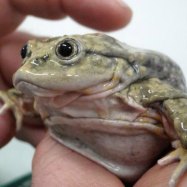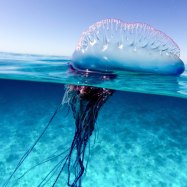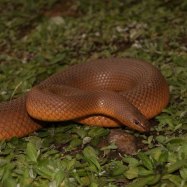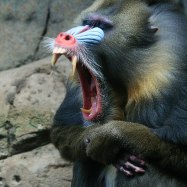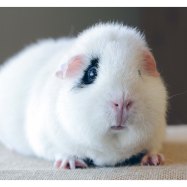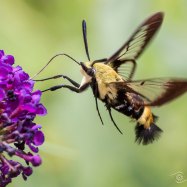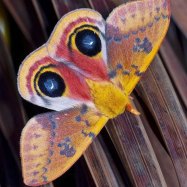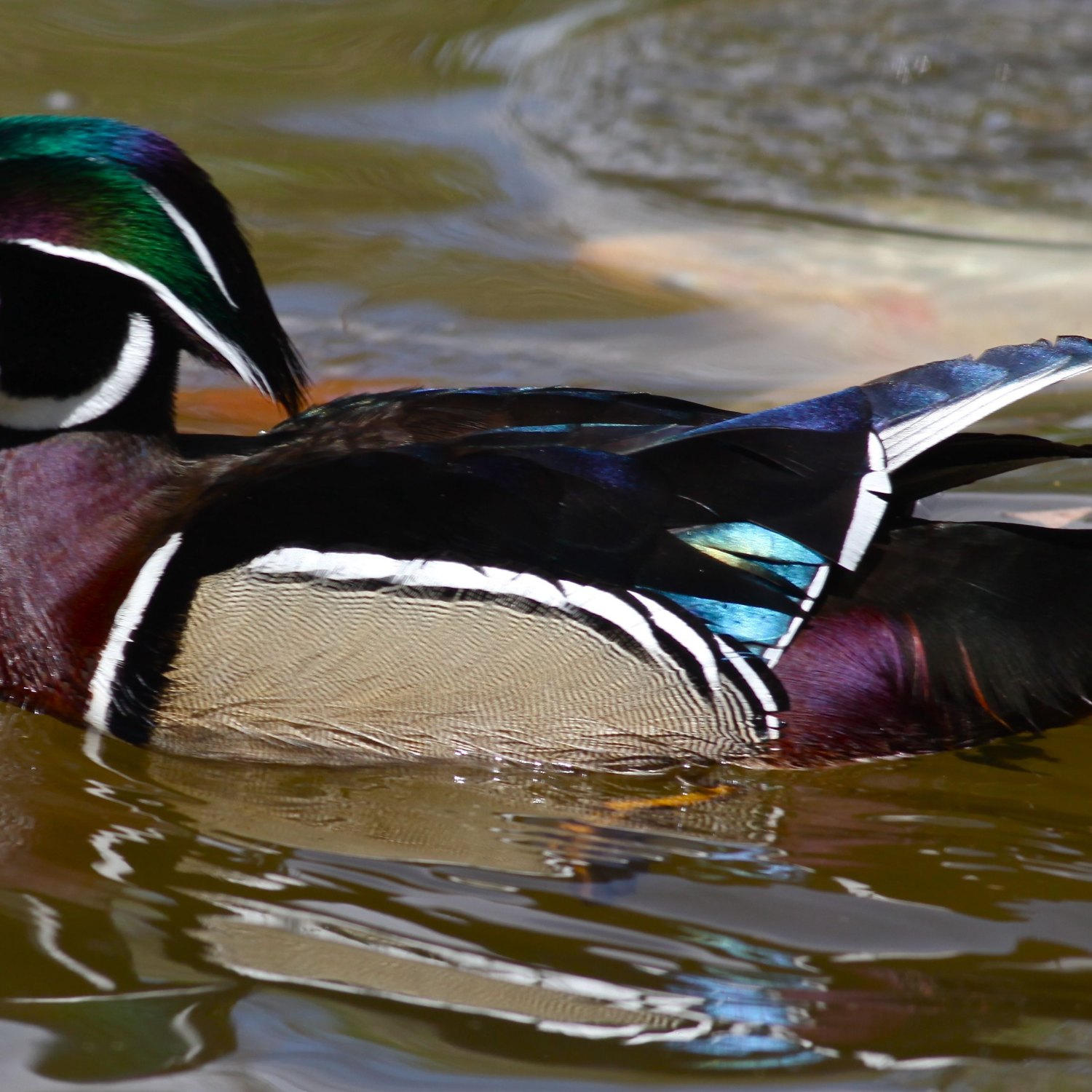
Wood Duck
47-54 cm (18.5-21.3 in)
The Wood Duck is a stunning bird found in Eastern North America. With a medium-sized, compact body and a long neck, this duck is a sight to behold. Its short crest and broad wings make it a skilled flyer, while its average length of 47-54 cm makes it a manageable size. Belonging to the Anatidae family, the Wood Duck is well-adapted to its natural habitat and a delight to observe.
Animal Details Summary:
Common Name: Wood Duck
Kingdom: Animalia
Habitat: Wooded wetlands, swamps, marshes, ponds
The Spectacular Wood Duck: The Shining Jewel of North America's Wetlands
It is a crisp spring morning, and you are walking through a wooded wetland, surrounded by the sounds of nature. Suddenly, you hear the unmistakable call of a wood duck, and your eyes are drawn to a dazzling creature flying overhead. Its bright, multicolored plumage captures your attention, and you cannot help but wonder what kind of bird it is. Well, your mystery bird is none other than the magnificent Wood Duck, the shining jewel of North America's wetlands Wood Duck.Scientifically known as Aix sponsa, this stunning bird is part of the animal kingdom, phylum Chordata, class Aves, order Anseriformes, and family Anatidae. They have been given the common name, Wood Duck, due to their preference for wooded wetlands, where they find various food sources and safe places to raise their young.
A Fascinating Habitat
The Wood Duck can be found in wooded wetlands, swamps, marshes, and on the edges of ponds and lakes. These locations provide plenty of food sources, nesting sites, and protection from predators. They are most commonly found in eastern North America, especially in the United States and Canada. However, some populations have also been recorded in Mexico, the Caribbean, and parts of Asia.Although they are classified as a species of "least concern" on the International Union for Conservation of Nature's (IUCN) Red List, the Wood Duck population in North America drastically declined in the early 20th century due to hunting and habitat destruction. Thanks to conservation efforts and reintroduction programs, their numbers have since rebounded, and they can now be found throughout their natural range.
A Versatile Diet
The Wood Duck is an omnivorous bird, meaning it has a varied diet consisting of both plant and animal matter Wood Turtle. They primarily feed on aquatic plants, acorns, seeds, and insects, but they also have a taste for snails and small fish. Their diet changes depending on the season, with a greater emphasis on insects and small animals during the breeding season.As their name suggests, Wood Ducks are highly skilled at finding food in wooded areas. They use their long, sharp claws to perch on branches and use their strong bills to dig into trees for insects and larvae. They also dive headfirst into shallow water to catch small fish and aquatic invertebrates. Their versatility in food choices allows them to thrive in different habitats, making them an adaptive and successful species.
Gorgeous Plumage
One of the most striking features of the Wood Duck is its colorful plumage, particularly in males. They have a bold, iridescent coloration with metallic green, red, purple, and white markings. This vibrant coloration not only makes them stand out in their natural habitats but also plays a vital role in attracting a mate.On the other hand, female Wood Ducks have a more subtle appearance, with a combination of brown, gray, and white feathers. This duller plumage acts as camouflage, allowing them to blend into their surroundings while nesting and caring for their young. This difference in coloration between males and females is called sexual dimorphism, a common characteristic in many bird species.
A Unique Body Shape
In addition to their stunning plumage, Wood Ducks also have a unique and distinctive body shape. They have a medium-sized, compact body with a long neck, short crest, and broad wings. This body shape is essential for their preferred habitats as they need to maneuver through dense vegetation and fly through wooded areas.The Wood Duck's broad wings make them excellent fliers, reaching speeds of up to 40 miles per hour to escape predators or migrate to warmer areas during the winter. While their long necks allow them to reach into tight spaces for food, their short crest adds another touch of elegance to their appearance.
The Ideal Measurements
The average Wood Duck measures between 47-54 cm (18.5-21.3 in) in length, making them a medium-sized bird. Their wingspan ranges from 66-73 cm (26-29 in), making them a bit wider than their body length. Despite their relatively small size, Wood Ducks are surprisingly heavy, with males weighing between 454-680 g (1-1.5 lbs) and females weighing between 454-1,600 g (1-3.5 lbs).A Cultural Icon
Wood Ducks have become more than just a beautiful bird in North America; they have become a cultural icon. Their striking appearance and unique behavior have captured the hearts and imaginations of people all over the world. They have been featured in numerous works of art, including paintings, sculptures, and even stamps.The conservation efforts made towards the protection of Wood Ducks have also helped raise awareness and shed light on other endangered wetland species. Additionally, their presence in popular culture has helped educate the public on the importance of preserving wetlands and the diverse species that call them home.
Wood Ducks and Humans
Despite their name, Wood Ducks are not entirely dependent on wooded environments. They are also adaptable to human-altered habitats, such as suburban ponds, golf courses, and city parks. These man-made water bodies provide the birds with another source of food and nesting sites.Wood Ducks also have a strong cultural significance for indigenous communities in North America. In many Native American societies, Wood Ducks are seen as symbols of fertility, hope, and survival. Some tribes even have Wood Duck dances as part of their cultural traditions.
A Bright Future Ahead
Thanks to conservation efforts and reintroduction programs, the Wood Duck population in North America has recovered significantly from its decline in the early 20th century. The North American Waterfowl Management Plan has played a crucial role in the protection and management of these birds, as well as other wetland species.The key to the future survival of Wood Ducks is the preservation and protection of their habitat. Wetlands are essential for these birds and provide vital functions such as flood prevention, water filtration, and carbon storage. By conserving and restoring wetlands, we can ensure not only the survival of Wood Ducks but also support a diverse ecosystem that benefits both humans and wildlife.
In conclusion, the Wood Duck is a truly fascinating and beautiful creature, with its colorful plumage, versatile diet, and unique body shape. They have played a significant role in North American culture, and their conservation efforts have brought attention to the importance of preserving wetlands. As we continue to learn more about these magnificent birds, let us strive to protect their habitats and ensure their future survival for generations to come. So, the next time you walk through a wooded wetland, keep an eye out for the dazzling Wood Duck, the shining jewel of North America's wetlands.

Wood Duck
Animal Details Wood Duck - Scientific Name: Aix sponsa
- Category: Animals W
- Scientific Name: Aix sponsa
- Common Name: Wood Duck
- Kingdom: Animalia
- Phylum: Chordata
- Class: Aves
- Order: Anseriformes
- Family: Anatidae
- Habitat: Wooded wetlands, swamps, marshes, ponds
- Feeding Method: Omnivorous, eats aquatic plants, acorns, seeds, insects, snails, and small fish
- Geographical Distribution: North America
- Country of Origin: United States and Canada
- Location: Eastern North America
- Animal Coloration: Males have colorful plumage with metallic green, red, purple, and white markings, while females have duller brown and gray plumage
- Body Shape: Medium-sized, compact body with a long neck, short crest, and broad wings
- Length: 47-54 cm (18.5-21.3 in)
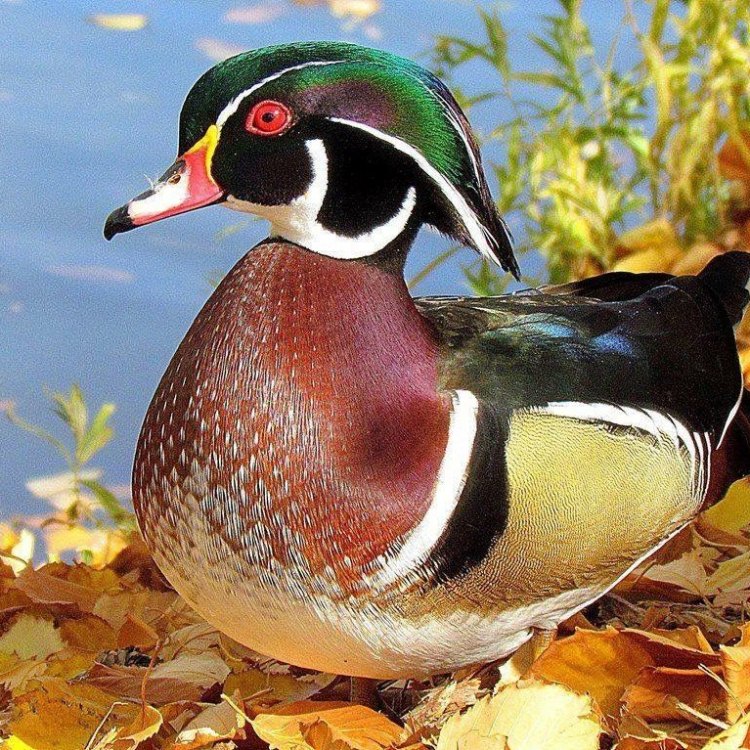
Wood Duck
- Adult Size: Medium
- Average Lifespan: 1-5 years
- Reproduction: Sexual
- Reproductive Behavior: Monogamous, nests in tree cavities near water
- Sound or Call: Males have a whistle-like call, females make a loud quacking sound
- Migration Pattern: Migratory, breed in northern regions and winter in southern regions
- Social Groups: Solitary or small flocks
- Behavior: Wood Ducks are highly skilled swimmers and can perch on branches and nest in tree cavities
- Threats: Habitat loss, hunting, competition with other bird species
- Conservation Status: Least Concern
- Impact on Ecosystem: Wood Ducks help disperse seeds and control insect populations in wetlands
- Human Use: Hunting, bird watching
- Distinctive Features: Males have distinctive metallic plumage and white patches on the face, females have a white eye-ring
- Interesting Facts: Wood Ducks are the only ducks that nest in tree cavities
- Predator: Raccoons, foxes, snakes, owls
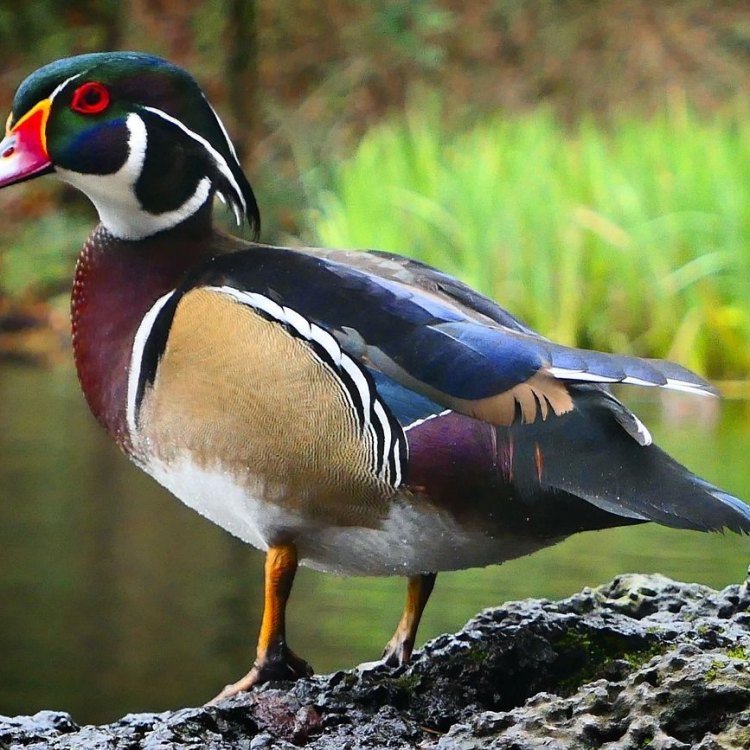
Aix sponsa
The Fascinating World of Wood Ducks: A Story of Survival and Beauty
The tranquil sound of water gently flowing in a calm river, the rustling of leaves as a gentle breeze passes through the trees, and the distinct whistle of a male Wood Duck, all create a serene setting in nature. These beautiful and unique creatures are admired by many for their stunning appearance and captivating behaviors. However, the Wood Duck's story goes far beyond its aesthetic appeal. It is a remarkable tale of survival, adaptability, and the crucial role it plays in its ecosystem PeaceOfAnimals.Com.Size and Reproduction
At first sight, a Wood Duck may seem like your average duck - medium-sized and cute. But upon closer inspection, you will notice that they are quite different from other species. These ducks are known for their bold and vibrant colors, which earned them the nickname "Summer ducks." They have an average adult size, ranging between 47-54 cm (19-21 inches), making them slightly larger than a Mallard duck. However, their most impressive feature is their long tail, which can measure up to 20 cm (8 inches) in length.
Wood Ducks have a relatively short lifespan, with an average of 1-5 years. However, they have a high reproductive rate, laying an average of 12 eggs per clutch. Interestingly, Wood Ducks are sexually reproducing and have a monogamous reproductive behavior. This means that they mate with only one partner during the breeding season, and they often return to the same mate and nesting site year after year White Sturgeon.
Nesting Habits and Unique Sounds
The Wood Duck's choice of nesting habitat is quite distinctive compared to other duck species. They nest in tree cavities, usually near water bodies, such as ponds, lakes, and rivers. These tree cavities are often located in mature trees, such as oak, sycamore, or cottonwood, although they have been known to nest in man-made structures such as nest boxes. This behavior makes them the only ducks that nest in tree cavities.
The Wood Duck's vocalizations are just as unique as its nesting habits. The males have a distinctive whistle-like call, while the females make a loud quacking sound. This difference in vocalization helps them communicate with each other during the breeding season, making it easier for them to find a mate and keep track of their offspring.
Away for Winter: Migratory Pattern
Like many other bird species, Wood Ducks have a migratory pattern, where they breed in northern regions during the spring and summer and then migrate to their wintering grounds in the southern regions. Their migration journey can span up to 1,500 miles, with some Wood Ducks traveling in flocks of 75,000 individuals. This behavior not only helps them escape the harsh northern winters but also provides them with a diverse range of habitats and food sources.
Social Behavior
Wood Ducks are generally solitary birds, often staying in pairs or small family groups. However, during migration and wintering grounds, they can be seen in larger flocks. These groups are dynamic, with individuals coming and leaving frequently, and the size can range from as few as five birds to several hundred.
When it comes to interactions among each other, Wood Ducks are quite tolerant. They rarely engage in aggressive behaviors, and their mating rituals are usually peaceful. However, conflicts can occur, mainly when resources are scarce.
Adaptable Behaviors
Wood Ducks have an impressive set of skills that allow them to thrive in various environments. They are highly agile swimmers, able to maneuver through dense forested areas on water bodies with ease. They also have the unique ability to perch on branches, thanks to their long talons. Besides perching, they can also fly swiftly and gracefully, reaching speeds of up to 45 miles per hour.
In addition, Wood Ducks are expert cavity nesters. Their sharp claws and strong beaks help them excavate tree cavities, and they also use their feathers to make a comfortable nesting site for their eggs. This behavior is a result of competition with other bird species for nesting sites, as well as a defensive tactic against predators.
Threats and Conservation Status
Unfortunately, Wood Ducks face various threats, mainly due to human activities. Habitat loss is one of the most significant threats they face. The clearing of forests and wetlands for agriculture and urbanization has significantly impacted their nesting and foraging habitats. Hunting has also been a significant source of mortality, as Wood Ducks are a prized game bird in North America.
Fortunately, due to their high reproductive rate and adaptability, their conservation status is listed as "Least Concern" by the International Union for Conservation of Nature (IUCN). However, continued conservation efforts are essential to ensure their survival and well-being.
Impact on the Ecosystem
Wood Ducks play a significant role in maintaining the balance of their ecosystems. As they forage for food, they help disperse seeds, leading to the growth of vegetation in wetland areas. This vegetation provides shelter and food for other animals. They also play a crucial role in controlling the population of insects in wetlands, helping to prevent the spread of diseases.
Human Use and Appreciation
The Wood Duck's unique characteristics and striking appearance have made them a popular subject for bird watchers and nature photographers. Their adaptability and ease of breeding in captivity also make them an excellent species for conservation and reintroduction programs. Additionally, they are a popular game bird for hunting, with regulated hunting seasons in North America.
Distinctive Features and Interesting Facts
One cannot talk about Wood Ducks without mentioning their distinctive features. The males have a uniquely colored metallic plumage, with hues of red, green, and blue, and a white patch around their eye area. In contrast, females have a mainly brown and white coloration, with a white eye-ring. These features make them stand out even in a group of other migratory birds.
Did you know that Wood Ducks are the only duck species that change the color of their plumage? During the breeding season, the males' colors become more vibrant, while the females' colors become more muted. This change in coloration is believed to serve as a form of camouflage and also to attract a mate.
Predators
Wood Ducks face various threats from predators such as raccoons, foxes, snakes, and owls. These predators often prey on their eggs and hatchlings, making nesting and raising offspring a challenging and dangerous task for Wood Ducks. However, their adaptability and nesting behaviors have helped them minimize these threats and thrive in various environments.
In Conclusion
The Wood Duck's story is one of resilience, beauty, and adaptability. From their unique nesting habits and vocalizations to their remarkable abilities to swim and fly, these birds have captured the hearts of many. Although they face various threats, their conservation status remains stable, and with continued efforts, we can ensure their survival for generations to come. So, the next time you hear the distinct whistle of a male Wood Duck or spot a pair swimming in a calm river, take a moment to appreciate these remarkable creatures and the role they play in our ecosystems.
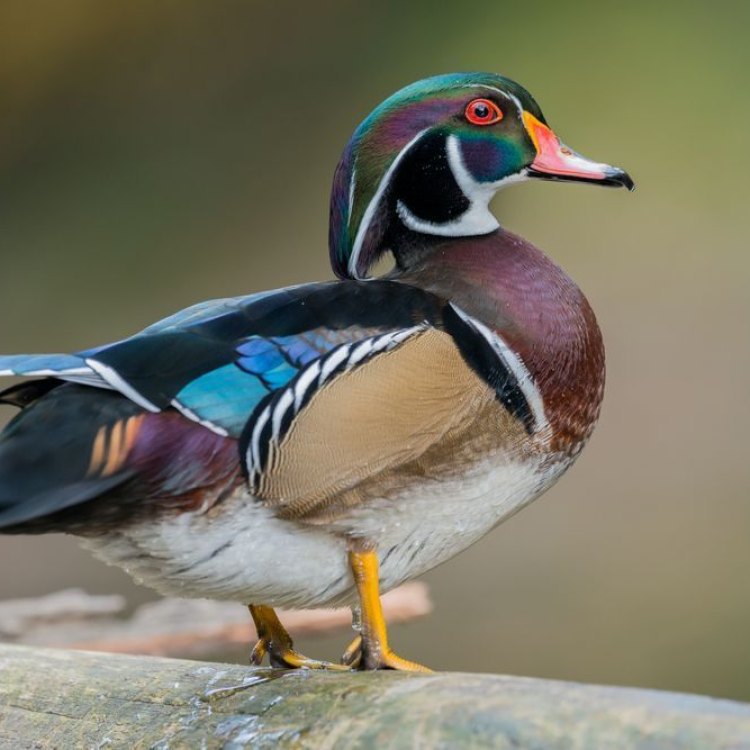
The Spectacular Wood Duck: The Shining Jewel of North America's Wetlands
Disclaimer: The content provided is for informational purposes only. We cannot guarantee the accuracy of the information on this page 100%. All information provided here may change without prior notice.


